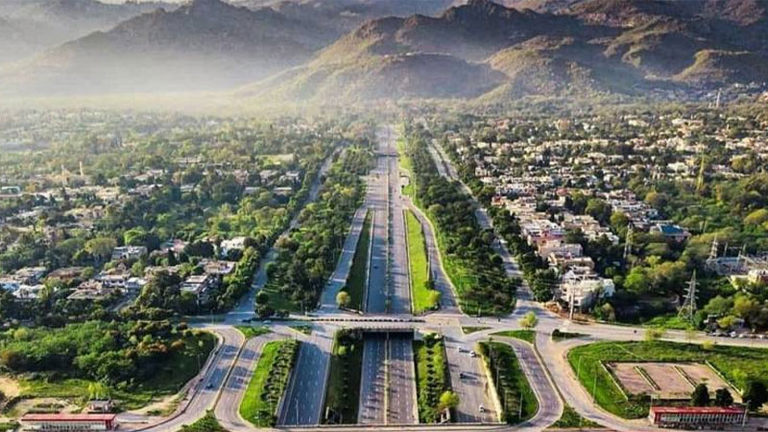Islamabad’s Environmental Crisis: Unplanned Urban Expansion and Air Quality Decline

Islamabad:Over the past few years, major urban centers in Pakistan have been grappling with severe environmental pressures. As winter approaches, cities like Lahore, Karachi, Peshawar, and Quetta are facing worsening air quality, with high Air Quality Index (AQI) levels and increasing smog. Despite having a relatively better green area compared to other major cities, Islamabad has recently found itself at the top of Pakistan’s most polluted cities, with its AQI ranging between 200 and 300 over the last month.
According to the World Health Organization (WHO) standards, a healthy air quality index should range between 30 and 50. So, what are the reasons behind Islamabad’s air pollution, what steps is the Environmental Protection Agency (EPA) taking, and what significant threats do the city’s unplanned urban developments pose to its environmental future?
### **From a Model City to Uncontrolled Urban Sprawl: Islamabad’s Environmental Decline**
Islamabad, once hailed as Pakistan’s most model city with its meticulously planned sectors, is now facing a major environmental crisis. Over the years, the unchecked spread of private housing societies has led to the city becoming just like any other urban center in Pakistan, sprawling without any planning. From 2001 to 2024, an estimated 13 hectares of “green cover” has been lost, meaning that the number of trees and green areas in the city is rapidly declining. Everywhere you look, advertising boards for housing societies testify that this unplanned expansion will only increase, further reducing green cover and potentially raising the AQI to unprecedented levels.
### **Ignoring the Master Plan: The Destruction of Islamabad’s Environment**
Islamabad’s original master plan envisioned a well-organized, modern city. However, today, the reality of urban sprawl tells a different story. According to Dr. Sohail Yusuf, head of the Environmental Department at Quaid-e-Azam University, urbanization itself is a major cause of air pollution. He emphasized, “Unfortunately, the expansion of cities without planning has further destroyed the environment. Unplanned urban sprawl reduces green areas, depletes essential gases needed for the environment, and increases the number of cars, which contribute to higher carbon emissions. As the city expands, so will its environmental destruction.”
### **Preserving Islamabad from Becoming a Concrete Jungle**
Dr. Sohail Yusuf points out that while high-rise buildings are a global trend, Islamabad’s obsession with large, single-family homes is proving costly. The city is expanding in all directions with little attention to green areas. “It seems that agencies involved in implementation are not prioritizing this,” he said. “New societies and sectors should make special efforts to preserve green spaces. Expansion of cities is not the problem, but it must be done according to a master plan.” He further suggested that public transportation should be improved, and efforts should be made to shift vehicles to clean energy sources. Currently, more than 60% of vehicles in Pakistan run on fossil fuels.
### **EPA’s Inability to Monitor Air Pollution Effectively**
The Pakistan Environmental Protection Agency (Pak-EPA) in Islamabad has been unable to take effective measures to improve air quality. Even though the city’s air quality is deteriorating, questions are being raised about the EPA’s ability to monitor it accurately. The sensors installed by EPA to measure air pollution are not functioning optimally due to a lack of timely repairs. These sensors were installed with the help of Japan several years ago, but due to the failure to maintain them, their effectiveness has been compromised.
### **Smog Towers: A Solution for Air Quality?**
Dr. Sohail Yusuf expressed skepticism about short-term solutions like artificial rain or the installation of smog towers, as seen in Lahore. He argued that such measures do not provide sustainable solutions and have minimal impact on the long-term air quality. “Pakistan has some of the most advanced air quality measurement instruments, and it would be more effective for the government to focus on policy enforcement. Air pollution, especially from vehicles, is a major issue, and public transport must be improved.”
### **Why Is Pakistan’s Academia Not Producing Practical Solutions for Air Pollution?**
Globally, top academic institutions are conducting research on environmental issues like climate change and air pollution. But is Pakistan’s academic sector contributing enough to solving these problems? Dr. Mukhtar, Chairman of the Higher Education Commission (HEC), explained, “There is no doubt that addressing climate change and air pollution is a priority for HEC. We are trying to get universities to focus on these issues, and we are funding research in climate-centric fields. There is also ongoing research on air pollution, and we have funded special studies to address it.”
However, Dr. Sohail Yusuf expressed concerns about the limited capacity of Pakistan’s academia to conduct high-impact research on environmental issues. “Academia is working on environmental issues, but the level of research is still insufficient. Our universities need to conduct problem-solving research. The real issue lies not in research but in its implementation,” he said. He suggested the formation of a national consortium involving academia, industry, decision-makers, and implementing agencies to solve environmental problems more effectively.
### **National Clean Air Policy: A Step Towards Addressing Air Pollution**
The federal government has recently approved the National Clean Air Quality Guidelines, which aim to control air pollution by 80%. According to the Planning Commission of Pakistan, climate change is rapidly depleting underground water reserves. If left unaddressed, it is expected that by 2080, the Earth’s temperature could rise by an additional 2-4 degrees. Under the National Clean Air Policy, emissions from transport, agriculture, and industrial smoke could be reduced by 81%, which would significantly improve air quality. However, there are still serious challenges like water storage capacity, poor irrigation systems, and the impact of climate change on crop production that need to be tackled.





